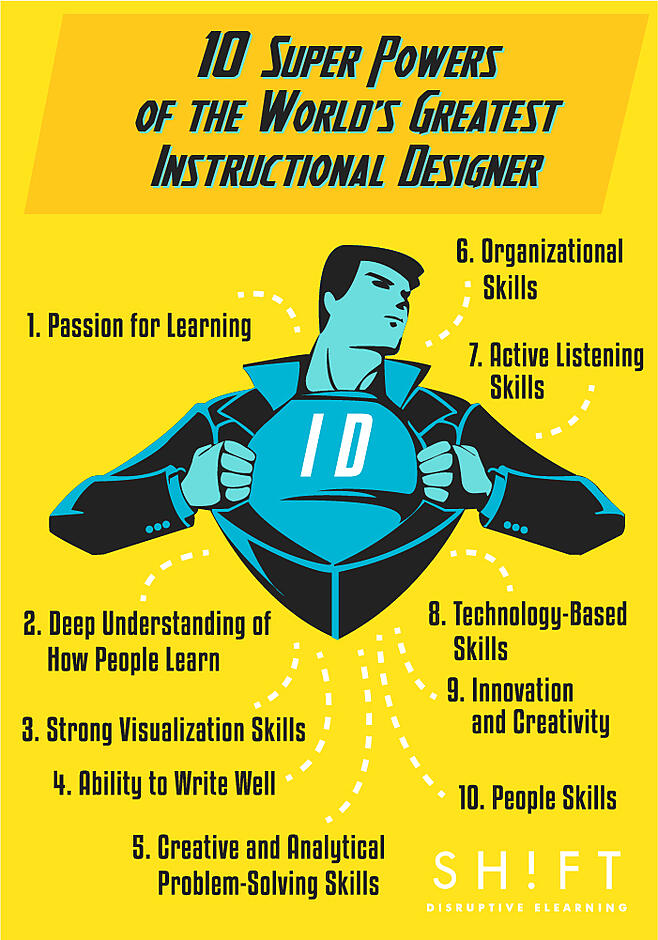Any professional eLearning designer would agree that users are always at the heart of what they do. The bulk of our articles last year focused on users. But what about designers themselves? Who are they? What impressive feats do they perform? What skills do they possess? How crucial is their role in developing educational materials for a new generation of learners? Let’s not forget about these oft-overlooked professionals who help make eLearning possible, personal, effective and immediately applicable.
That’s why we’re going to start the year with this quick list of super powers every excellent instructional designer has:

1. Passion for Learning that Borders on Obsession
Instructional designers share a passion for learning. But the great ones are obsessed with learning everything and anything that has to do with learning.
They constantly seek new topics to learn and teach, no matter which area or industry. They make time for reading—from studying the latest research in scholarly journals to checking out eLearning blogs and technology websites. And when they read, they’re also actively applying techniques and tricks they learn in their everyday instructional design work.
2. Deep Understanding of How People Learn
Non-professionals might have an idea of how people learn. Good instructional designers might know a set of strategies that aid students in recalling facts. Great IDs, however, go beyond the basics and not only rely on tactics and strategies. They clearly understand how people learn and have well-tested ideas on how to help them learn more effectively.
In sum, they design for how people learn. They don’t assume but rely instead on the contribution of experts and trained professionals even in other fields—psychology, neurology, usability, information technology and communications.
3. Strong Visualization Skills
The human brain, take note, is primarily visual. And it’s no longer a secret that we’re all visual learners. Great instructional designers know this. They know that people take in more information through the eye than in any other sense organs. But that’s not all. They also know the importance of seeing the big picture, of asking themselves “what’s the learning goal here?” They visualize it and see it from the perspective of a designer and a learner. They’re avid learners, remember?
4. Ability to Write Well
The ability to write well, they say, reflects the ability to think well. Great IDs, not surprisingly, are able to think and write way better than the others. They can craft a well-structured sentence, one that conveys ideas coherently and effectively. And they know which tone to use depending on the context too.
That’s why people should seriously consider their writing abilities before they begin a career as an instructional designer. It’s a rewarding yet tough career choice. There are ways to improve one’s writing skill, though, and potential designers can learn a lot from pros.
5. Creative and Analytical Problem-Solving Skills
Most of the time, super-powerful instructional designers are tasked to solve learning issues. And there are countless days when they’re compelled to come up with something new. The ability to tackle problems creatively and analytically is key here. That’s why the best IDs can quickly spot a problem, generate options and alternatives, and test them out to discover a solution.
6. Organizational Skills
Exceptional IDs have an eye for detail. They do, in fact, pay careful attention to every teeny bit of detail that goes into every learning material. Because they’re detail-oriented, these designers constantly organize, move, select, synthesize, summarize and edit information to make it effective.
7. Active Listening Skills
The International Board of Standards for Training, Performance and Instruction (IBSTPI) recognized the critical importance of active listening for a reason. Such a skill allows industry professionals to better understand a subject.
It also shows care and let others, especially learners, know that you are willing to see things from their perspective and are focusing on their needs. Asking relevant and well-timed questions is part of this active listening skill as well. Doing so helps clarify and define situations and statements, and eventually contribute to learning outcomes.
8. Technology-Based Skills
Exceptional IDs share a deep understanding of how technology can aid the field of instructional design and learning. They don’t blindly follow trends. They can, however, take a look at a piece of software, and see how it’s going to benefit their workflow or not. They can pick up almost any tool and learn how to use it without needing a month or two of formal training.
9. Innovation and Creativity
The hyper-connected and dynamic environment demands instructional designers to innovate and think of creative ways to keep the learner engaged. Such call for innovation, however, must consider the limitations of budget and client requirements. High-performing IDs know how to balance these. They know how to go beyond just providing interactivity, they know how to present the content intelligently.
What’s more, their creative minds find inspiration everywhere, from the books they read to a commercial they just saw on TV.
10. People Skills
It’s obvious why IDs need to possess strong people skills. They constantly work in collaboration with others. They simply cannot work alone. Great IDs who are able to create effective instructional systems have overcome objections from people and have worked closely with knowledge experts and students. They also have resolved an unbelievable number of issues and conflicts, and persuaded people into working with them toward their designed project goals.









